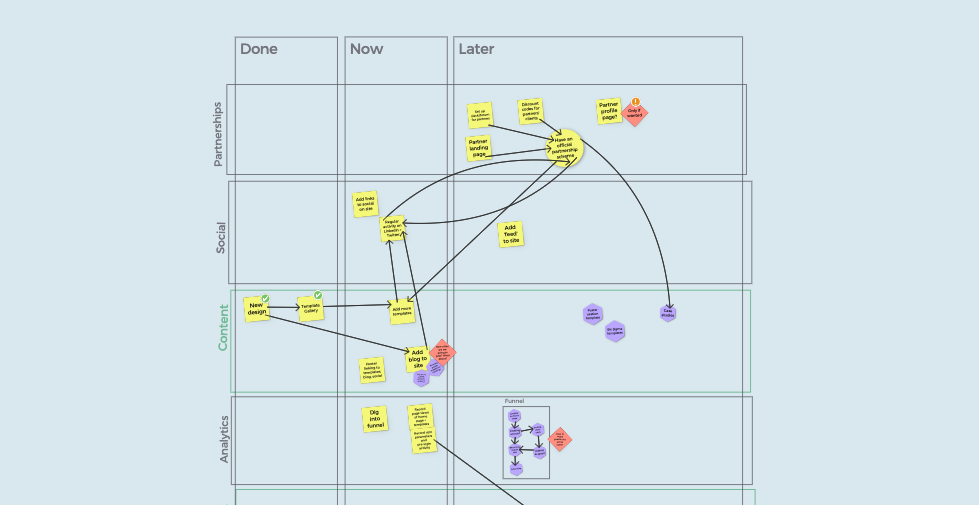The Planstorm
Planstorm noun
- A technique for developing a plan out of a complex and dynamic environment
In any project you probably experience a regular but surprising moment where things are sailing along smoothly, and then suddenly they're not. Something changed that you didn’t see coming; A deadline or constraint appeared, someone joined or left the team, or you finished the current cycle of work, and now you don’t know what to focus on or prioritise next. All the work that was ticking over nicely now needs rethinking and you can’t keep it all your mind at once to figure it out.
Whenever the landscape changes like this, there’s a technique that I’ve stumbled across to get back on track and get my thoughts in order. It’s basically a brainstorming session that turns into a plan, so I’m going to call it the... Planstorm, because I’m bad at naming things!

How does it work?
There are three steps to a Planstorm:
- Brainstorm
- Connect
- Plan
It’s not a strict process - you just get everything out of your head onto sticky notes in front of you, group & connect them up, and then turn those connections into some kind of a plan.

Brainstorm
Your first goal is to get everything out of your head. This alone can be enough to give you clarity on how to proceed.
We can only hold a limited amount of information in our working memory at once. If you want to see how a few ideas or tasks fit together, then you can just think it through. But when there’s too much to keep in your head you’re going to need to get it down in writing, so that you can see it all at once.
Don’t worry about trying to fit it all together or even make sense of it yet. Just spend some time writing down all the tasks, ideas, and worries that you have bouncing around in your head. You can always throw away things later, so err on the side of writing down everything, even if it doesn’t seem like it’ll be relevant.
Connect
Now you’ve got your thoughts down, start to group and connect them. If a task depends on another task, draw an arrow between them. If an idea is related to another idea, group them together. If something is important, mark it as special with a sticker, tag or ⭐ emoji.
If you’re working towards a deadline, make sure that everything needed to complete the deadline is connected to it.
Plan
The final step is to organise all of your thoughts so far into a plan. This is where you get some clarity out of your previous brainstorming: understanding your top priorities, what you should be working on, or how to best split up work between your team. How you do this will depend on what sort of question you’re trying to answer:
- Which tasks are most important to keep a project moving? Put your deadlines or goals on the right hand side, and then work backwards from them, ordering the dependencies between tasks. You’ll end up with something like a simple Gantt chart showing you which tasks are blocking others, and which to tackle next.
- Who should work on which tasks? Give each person a row, and then assign notes to each person, with their immediate tasks on the left, and later tasks on the right. You can make sure that everyone has an even workload, and see if anyone is going to be blocked by other people’s work.
- How many different sub-projects can things split into? If you’ve ended up with some natural groupings of dependencies and connections, then maybe your project can split into a few loosely connected sub-projects. This can help to get work moving in parallel, or help you to understand how to prioritise certain tasks if some sub-projects are less important than others.
- Can any bits of scope by cut? Once you can see the dependencies between tasks, and how many people you have to work on them, there are sometimes a few tasks that stand out not being that important, but will be a significant amount of work or hold up other areas. So don’t do them!
Typically I find that a Planstorm ends up being a little bit of all of these.
When to use a Planstorm
You can use a Planstorm whenever you need to pull some clarity out of a dynamic and complex situation. This could be for planning the overview of the sprint cycle, or at regular intervals in a long-complex project.
I personally used it to navigate my way through an 18 month project without around 15 other team members. A regular Planstorm helped me to keep track of what we needed to do to hit our next milestones, how to organise the work so that developers could work in parallel, and make sure that the riskier parts of the project were tackled up-front while the less risky parts could be done closer to the deadline. About every 3-4 months, as we hit important milestones, I’d start again with another Planstorm that would serve as my reference point for the next stage.
Plans Are Worthless, But Planning Is Everything
- Dwight D. Eisenhower
The idea isn’t to come up with a perfect plan that you will now execute flawlessly. Instead, it’s a method of getting all the complexity and confusion out of your head and down in front of you, so that you can see it, sort it out, and most importantly, come to understand what the next concrete steps you need to take are to keep things on track.
 Online sticky notes to plan, organise and brainstorm with your team remotely
Online sticky notes to plan, organise and brainstorm with your team remotely